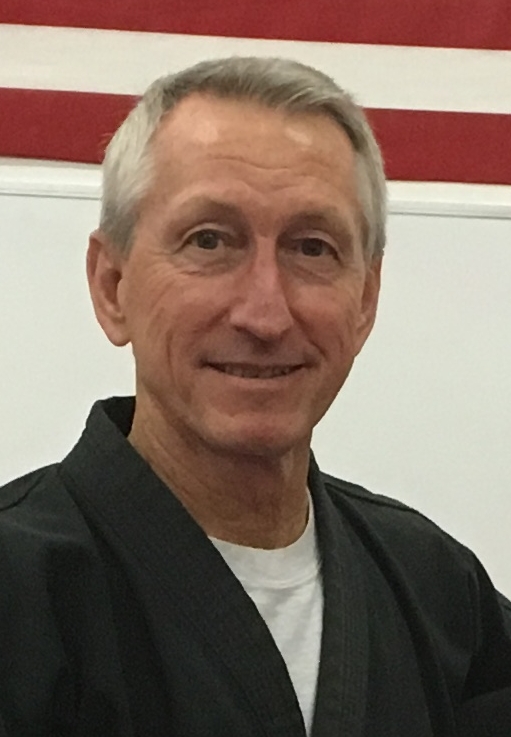
Professor
Michael Whittle
Hawaiian Martial Arts LLCEagle Plaza
204 S. Koren
Spokane, WA 99212
509 315-6172 (T)
whittlekajukenbo@gmail.com

About Professor Whittle
Bergstrom Air Force Base- Austin, Texas
I was sixteen years old when I joined the Bergstrom A.F.B. Kajukenpo Karate Club in 1968. I was a junior at Reagan High School in Austin, Texas. One of the guys in my P.E. class was already a member of the club and he invited me to come to class with him.
The class was held at the base gymnasium in the wrestling room. The class was primarily young airmen. Sensei Tony Lasit was the chief instructor. He had been assigned to Vietnam just before I joined the club so I never met him.
Sensei Jim Johnson was the black belt instructor in charge of the class when I joined.
We wore white uniforms and instructors wore black. Our club patch was a red circle with a white clover in the center. There were three different hand positions indicated on the clover. Kajukenpo was spelled with a 'P' at that time. Our belt rank system was white, purple, blue, green, brown and black. There were three brown belts awarded as 3rd degree, 2nd degree and 1st degree. It took one year to become eligible for your purple belt test and six months for each color belt test thereafter.
Classes were held on Tuesday and Thursday nights and were three hours long. We were aligned by rank from left to right in rows. When class began we stood at attention stance with our belt folded neatly at our feet. The instructor faced the class and bowed and everyone bowed to him. When the command was given we knelt down on the floor, picked-up our belts and tied them around our waist. When the command was given we stood tall in attention stance.
We started class with stretching exercises and calisthenics. Commands for stances, kicks, blocks, punches, strikes, break falls and roll drills were given in Japanese. The forms were called katas, the grab arts were called covers and the punch defenses were executed after being pushed forward, rolling and turning to face your attacker in cover. These techniques were called rolls. We fought at the end of every class. Everyone sat down one side of the mat. Usually the lowest ranked belt would bow onto the mat, walk down the line and face who he wanted to spar with. He would bow to him and back away to the center of the mat. The instructor controlled the match and called points.
Sparring was emphasized at this time. Karate was new and popular in the states. The fighting was more precise and controlled to avoid serious injuries. Safety punch and kick equipment had not been invented so bare feet and hands was how we fought. We had groin protectors and most of us invested in shin pads.
Sensei Jim Johnson completed his active duty in the Air Force and left Bergstrom in 1969. Tony Lasit promoted Dan Baker to black belt and he took over as Sensei.
In 1969 a new base commander was assigned to Bergstrom A.F.B. that hated long hair. An edict was given that no one with long hair was allowed on the base. I had long hair and was not about to cut it off for any base commander. I was not allowed to enter the gate of the base while he was base commander. He was finally reassigned to another base and left Bergstrom in 1970.
Ben Calvo had joined the club around 1970. Ben was a brown belt at that time and had previous training in another style of karate. His execution of kata was picture perfect. When I rejoined the class Sensei Dan Baker promoted me to green belt.
We went to a tournament in College Station, Texas when Ben was a brown belt and I was a green belt. Ben was disqualified for performing a kata that the judges believed was too advanced for his belt level! I was disqualified for kicking a guy in the face and busting his skin open on his cheek bone. That was my first tournament competition.
Sometime before 1972 Dan went to California to test for his 2nd degree black belt. I'm not certain, but I think it was with Vince Black in San Diego.
The rule for instructors was that they could promote to the belt level below their rank. Dan had to be a second degree black belt to promote anyone to first degree black belt.
Another rule was that the chief instructor had to sign to certificate for it to be valid. The chief instructor had to be a 5th degree black belt or higher. My black belt certificate has Dan as the instructor and Tony Lasit as the chief instructor. I was told that Tony Lasit had a 5th or 6th degree black belt in Shotokan Karate before joining the Kajukenpo Karate Club in Hawaii.
Ben was Dan's first black belt and was promoted in 1972. I was Dan's second black belt and promoted in 1974. Jay Vera was the third black belt promoted in 1975.
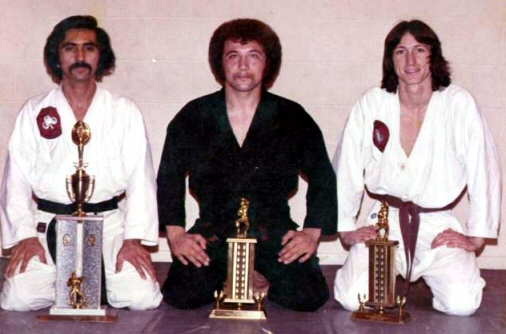
Ben Calvo, Dan Baker and Michael Whittle 1972
Ben's black belt test was the first black belt test I had ever seen. Dan drilled him and made him show everything he knew for three hours. When he and I fought he moved in when I turned to spin back fist, he was to close so my elbow hit first and caught him across the nose. The last time I saw Ben was in Austin at a seminar. He showed me the scar he still has on his nose as a memento of that day.
We had a constant influx of airmen joining and quitting the club. Some of them had been in Vietnam or other Asian assignments. Some came to class wearing black belts. Dan would always welcome them to the club. Let them work out with us and at the end of class match them up with a purple or blue belt to fight. They almost always lost and almost always never came back.
Jay Vera joined the class around 1973. He had a green belt in Gojo Ryu. He was a very talented martial artist in both fighting and form competition. Jay and I created the two man form that we teach in our syllabus today. We won first place with the form at a tournament in San Antonio, Texas. Jay is also memorable to me because he side kicked me in the ribs at my black belt test! He was just playing with me. I was so tired and I really wanted to get him back for that shot. It put me on my knees.
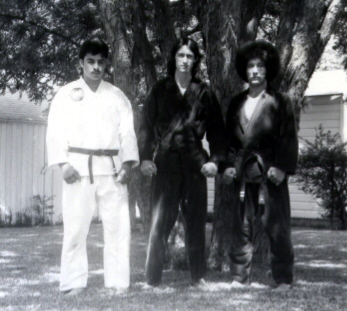
Vera, Whittle, and Baker 1974
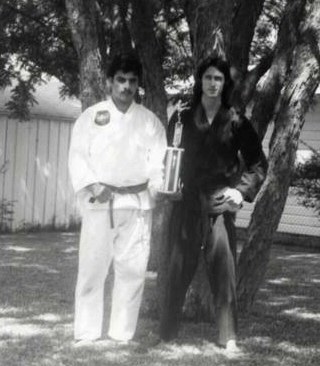
Vera and Whittle - 1st Place 2 Man Form 1974
Southwest Texas State University - San Marcos, Texas
Dan completed his active duty with the Air Force about 1972 and moved to San Marcos, Texas to attend school at Southwest Texas University. He continued to teach at Bergstrom and he started a Kajukenpo club at a community center in San Marcos. Dan wanted me to come to San Marcos and assistant instructing at the community center.
There was a group of us that would commute to San Marcos to participate in the new club. The first class in San Marcos was huge.
In 1974 Sensei Dan Baker promoted me to black belt and I took over the Bergstrom Kajukenpo Club.
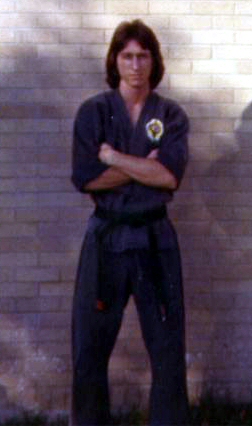
Whittle at Bergstrom AFB 1975
Jay and I kept the Bergstrom Club going and continued to assist at San Marcos. Ben Calvo moved away or quit coming to class after Dan left. I do not remember.
Dan moved the San Marcos club from the community center to Southwest Texas State University campus. It was an intramural activity and was very popular. We worked out in an area similar to a dance room adjacent to a gymnasium. It had wood floors and a mirror on one wall. We later moved the class to the mezzanine in the gymnasium.
When Dan graduated from SWTSU he took a coaching job at a high school inTexas. He left me in charge of the San Marcos club. I was not a student at the university and I was not a faculty member. The Kajukenbo Club put together a constitution and created a club that hired me as an instructor to teach the class. We had a small fee monthly that went into a new club fund for club related activities.
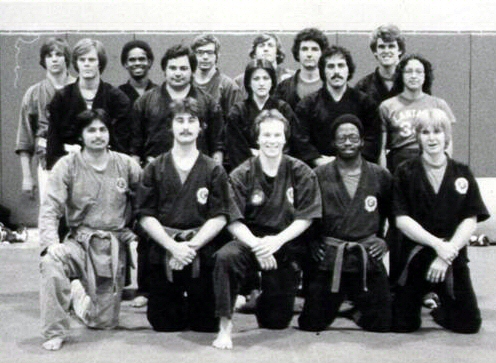
SWTSU Kajukenbo Club 1977
Jay completed his active duty in the Air Force and moved to Shreveport, LA about 1976. I stopped teaching at the Bergstrom Club and focused on the SWTSU club until I moved to Arizona in 1979.
Sifu Donald K. Nahoolewa
Jay and I took the Bergstrom group to a tournament in Abilene, Texas in 1975 and met Sifu Don Nahoolewa. I had never seen another Kajukenbo school at any tournament we had ever attended. I introduced myself to him and told him about our clubs in Austin and San Marcos. I inquired about coming to Ft. Worth to study from him and he agreed as long as I had permission from my instructor. I contacted Dan for permission and he encouraged me to learn as much as I could.
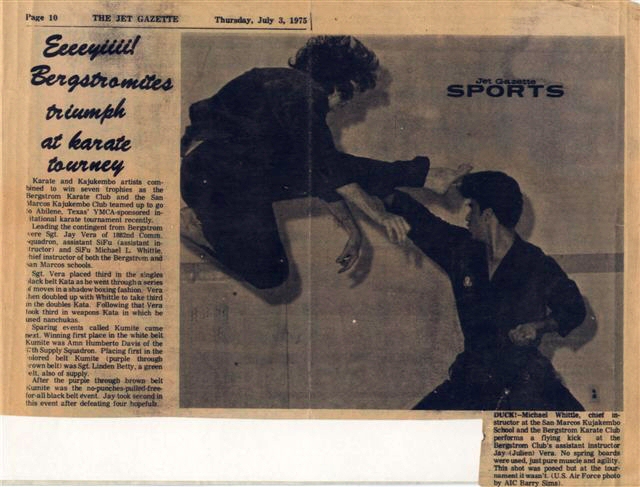
Whittle and Vera at Abilene Tournament 1975
I began driving to Ft Worth almost every Saturday to study from Sifu Nahoolewa. His school was in a local strip center. He had several black belts and they taught me as much as I could remember on every trip. This went on for three years. Most of the Kajukenbo that I teach today is what I learned from Sifu Nahoolewa. It is also worth mentioning that Sifu Nahoolewa never charged me any money for teaching me. It was enough that I would drive from Austin to Ft Worth to learn from him.
It was Sifu Nahoolewa who changed the spelling of Kajuke'n'bo to Kajuke'm'bo. He organized the American Kempo Association and was President until he retired in 1983. I was a regional director for the association from 1975 to 1979.
Sifu Nahoolewa awarded me my 2nd degree black belt and Instructors Certificate in 1975.
He awarded me my 3rd degree black belt and the title 'Sifu' in 1979.
Southwest Texas State University Karate Team
Dan returned to SWTSU in 1976 to work on his masters degree. He did not take over the existing Kajukenbo Club. He started a new class that was focused on tournament competition with other universities. He still taught the Kajukenpo that he had taught me but he was developing a team approach to competition within the Texas school system. He was very successful with his team. SWTSU was the number one Karate team from its inception and continued for as long as I knew about them.
Craig Speer and Jon Button were promoted to their black belts in 1977. They both assisted me with the SWTSU Kajukenbo Club until I left in 1979. Craig took over the classes after I left and taught at SWTSU until he opened his own school in Austin.

Speer and Button at BAFB
Arizona
My employer relocated me to Phoenix Arizona in 1979. I had decided before I moved that I wanted to study kung fu and take a break from teaching. I joined a Shaolin Kung Fu school not far from my house. Judd Tomaiko was the instructor and Gene Chicone was his teacher. I attended classes there for one year in 1980.
I met my wife Amy in Phoenix and began pursuit of my career in earnest. We moved six times over the next ten years and lived in four different states. During this period I did not teach Kajukenbo.
In 1990 Amy and I decided to move back to Phoenix. I sold my business in Newport Beach, California and we bought a home in Chandler, Arizona. I had decided before moving that I wanted to start a school again and called Dan Baker and Jay Vera to tell them my plans. Dan promoted me to 5th degree black belt in 1990.
In 1991 I opened a school in Gilbert, Arizona in a small shopping center. Classes were Tuesday and Thursday nights and Saturday mornings. I could only do this part time while I worked during the day. I looked for a different venue to teach classes and checked into the local community college. They set me up with a space and the same time periods I was currently teaching. I transferred all of my adult students to the college in 1993.
Danzan Ryu Jiujitsu
Sifu Nahoolewa taught a group of techniques called 'Throw Combinations'. I suspect that they were developed with assistance from Sam Alred. Sam Alred was a black belt in Judo before he met and joined Nahoolewa's Kajukembo school.
I wanted to learn more throws and grappling techniques and decided to join a Jiu Jitsu school. I found a school near me in the phone book that taught Danzan Ryu Jiu Jitsu. I had good luck that day! The instructor was Sensei Kirk Jaeger. His teacher was Joe Holck one of the original Kajukenbo founders. Kirk was an excellent instructor. He was very detail oriented. I studied Danzan Ryu from 1991 to 1996. I have integrated throw, lock and choke techniques from Danzan Ryu Jiu Jitsu into our Kajukenbo class syllabus.
KSDI Seminars
I met Moses Williams at the KSDI Seminar and Tournament in San Jose. He came to the tournament with Dan Baker. Moses' teacher had retired and asked Dan Baker to take Moses as his student. Moses background was in Kenpo and Hung Gar Gung Fu. Dan gave him rank in Kajukenbo that he felt was equitable with Moses skill level. Moses is one of the best martial artists I have ever met. We became friends and over the few years he taught me Hung Gar Gung Fu sets and Quans.
In 1997 I was promoted to my 6th black belt and given the title' Sigung'. Moses Williams performed the honors and gave me his 6th degree black belt. When Craig Speer was promoted to his 6th degree black belt in 2002 I presented him this same belt.
I met Professor Joe Davis at the KSDI Vallejo Seminar in 1997. He was the 3rd black belt promoted by Alejo Reyes. My teacher Don Nahoolewa was 1st, Richard Piralta was 2nd and I think Lee Hart was 4th. He had one of Don's old manuals and wanted to know if I knew the punch counters and how to do his form number 5. When we talked more I discovered that he knew the Alphabets and I asked him if he would teach them to me. I made a few trips to San Francisco and met Professor Davis at Professor Bautista's school and then later at his home to learn the techniques. He also taught me 10 hand techniques he learned from Al Dacascos.
In 1998 I met Olohe Solomon Kaihewalu at a martial arts function in San Diego. He performed some Lua techniques on the stage and I knew that I wanted to learn Lua. When I approached him about studying from him he pretty much just blew me off. He said he was only training his existing black belts. Later at the 1999 KSDI Seminar he taught Lua weapons and open hand techniques. Moses Williams, Tyrone Epps and I stayed with him all day.
I brought Olohe to our school in Arizona for a seminar in 1999. I joined his organization that year and have been his student ever since.
Dan promoted me to my 7th degree black belt in 1999. I wanted a certificate from Sijo Adriano Emperado and was awarded my 7th degree black belt by Sijo Adriano Emperado in Honolulu, Hawaii at the KSDI Seminar and Tournament at the Pacifica Hotel in 2000.
American Kajukembo Association
Donald K. Nahoolewa came out of retirement to establish the AKA in 2002. He wanted to organize the schools that had direct lineage to Alejo Reyes and Joe Emperado into an association based on common techniques and training methods. He asked me to join the association to support him in his effort to create a board of senior instructors who would teach the baseline techniques and be responsible for black belt certifications.
The AKA board awarded me my 8th black belt in 2002. The board members at the time included Don Nahoolewa, Sam Alred, Richard Piralta, Gerald Chavez, Jerry Wright and George Jackson.
Maricopa Community Colleges
I have been teaching Kajukenbo at Chandler-Gilbert Community College since 1993. During this period of time I have promoted seven black belts. All of them are active in the club and teach or assist instructing. In 2002 we added classes to the Williams Field location. In 2004 we opened classes at Mesa Community College and in 2005 we began classes at the Red Mountain location.
The community college offers students affordable adult classes in a professional school environment. We offer college credit and non-credit courses in the physical education department.
Hawaiian Martial Arts LLC
Hawaiian Martial Arts LLC offers classes for adults, teens and children.
We teach the following arts:
KAJUKENBO HAWAIIAN LUA DAN ZAN RYU JUJITSU
Kajukenbo Self Defense Institute of Hawaii (KSDI)
March 2011 SGM Donald Nahoolewa and GM Daniel Baker recommended my promotion to 9th degree black belt. The Board of Advisors for KSDI approved my promotion to 9th degree black belt at the 2011 KSDI Tournament and Seminar. I was whipped with Sijo Adriano Emparado's belt by SGM Dichi Emparado and the attending BOA members. GM Daniel Baker gave me the "Kiss of the Dragon" with Sijo Emperado's belt wrapped around his fist.
SGM Dichi Emperado presented my certificate of promotion to 9th degree black belt at the 2013 KSDI Tournament and Seminar. The certirficate was dated July 9th, 2011 and signed by all the attending grandmasters.
American Kajukembo Association (AKA)
SGM Donald Nahoolewa and the presiding members of the AKA board of directors presented me AKA Certification for "Grand Master" rank at the April 2013 AKA Seminar in Abilene, Texas. This certificate is from my "Ohana". Joe Emperado - Aleju Reyes - Donald K. Nahoolewa.